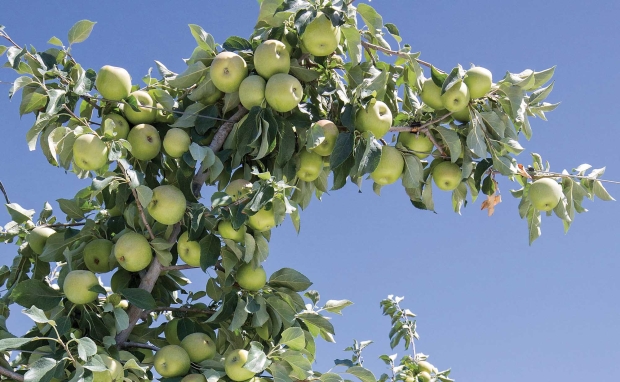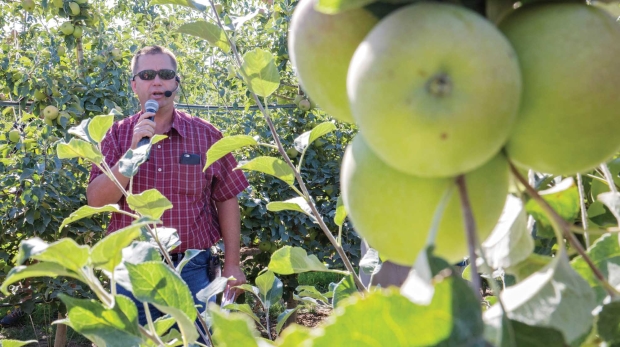
Bruce Allen leaves some Honeycrisp apples growing in clusters for part of the season to prevent them from growing too big. Bruce Allen computes how many linear feet of fruiting wood there are in the canopy and calculates how many fruit are needed per linear foot of branch to achieve his target yield. (TJ Mullinax/Good Fruit Grower)
Managing the crop load on Honeycrisp requires a precise and season-long effort of counting and thinning, growers say.
“We’ve gone from being eyeball farmers, and we now are trying to estimate our canopy volume per acre,” Bruce Allen, a large and long-time Honeycrisp grower, told members of the International Fruit Tree Association during their summer tour in Washington State.
“We compute how many linear feet of fruiting wood that is. We do a bud count in late fall and early winter and do a bud analysis under a microscope to figure out the percentage that are fruit buds,” he said.
Because Honeycrisp produces large fruit, it’s possible to produce 80 to 100 bins per acre if there’s a full canopy, he said. He works back from the target yield to calculate the number of fruit needed per linear foot of branch and then has workers try to prune the trees to leave 150 to 200 percent of that number.
The crop is then adjusted before bloom by removing whole clusters.
“Taking whole clusters off is a very effective—and expensive—way of maximizing the potential for consistent return bloom,” Allen said.
Leaving the remaining fruit in clusters for part of the season helps prevent the fruit from growing too big.
That’s followed by a “very modest” chemical bloom thinning program using fish oil and lime sulfur to try to reduce the clusters to singles, doubles, or triples, with follow-up thinning by hand. If there’s still excess fruit on the tree, workers thin again, removing the largest fruit.
“We’re trying to get away from growing 56s and 48s,” Allen said.
Growers will need to figure out the right number of target fruit per foot for their particular orchard. “But if you’re trying to grow five to six fruit per linear foot, that’s too many,” he said. “You can’t do it. You’d have biennial bearing and inferior eating quality.”
With most varieties—particularly Honeycrisp—fruit on overcropped trees won’t color and won’t taste good, he said. An exception is Gala, which can yield 100 bins per acre and still have acceptable internal quality.
“We have to figure out how to deliver good tasting fruit and still have yields in the 80, 90, 100 bins per acre range,” Allen said.
Stemilt
At Saddle Mountain West Orchard in Othello, which is operated by Stemilt Ag Services, orchard manager Juan Cuevas explained the company’s strategy to avoid biennial bearing and manage fruit size.
Buds are examined in winter under a microscope. Fruit buds are counted in order to compile the first crop load estimate and develop the pruning strategy.
Pre-bloom, clusters are counted and half of them removed. The number of buds in each remaining cluster is then reduced. Cuevas said it’s easy to explain to workers that they need to reduce the buds from five to three, for example.
Before green fruit thinning, the manager will have figured out how many fruit are needed per tree to produce the desired yield.
“Before we start hand fruit thinning, we make sure we know how many fruit per tree and per acre we need,” Cuevas said. “Don’t have people just start throwing fruit on the ground.”
A person needs to count the fruit on a couple of trees to demonstrate to the crew what a tree with, say, 120 apples looks like versus a tree with 170, he said.

Dale Goldy talks about managing Honeycrisp through better thinning practices on the first day of the IFTA Washington tour on July 15, 2015. (TJ Mullinax/Good Fruit Grower)
Dale Goldy, assistant general manager at Stemilt Ag Services, said they used to use a chemical bloom-thinning program of lime sulfur and oil but they would either get too much thinning or not enough.
When the crop was overthinned there was inadequate return bloom and the risk of bitterpit increased.
When the crop was underthinned it exacerbated Honeycrisp’s tendency to produce large fruit, so the apples were enormous. Also, overcropped trees tend to produce low quality fruit.
“With the cluster thinning we’ve been doing, it’s taken away the risk of overthinning or underthinning,” he said, estimating the cost of hand cluster and fruit thinning at $2,000 per acre. “With the value of the crop, the cost of hand cluster thinning is not significant. The process from prebloom to the end of July of slowly adjusting the crop load to the right amount is a huge part of our bitter pit/fruit size strategy, plus getting resting spurs in there to get our return bloom.”
Goldy said as harvest approaches it’s important to thin again to make sure there are no triples. Because of the size of the fruit, apples in clusters tend to knock each other off as they grow.
“With our fruit size, you can’t go to harvest with triples,” he said.
If there are still too many apples on the tree when the fruit is thinned to doubles, the crew takes off whole doubles, rather than thinning to singles, because of the difficulty of removing one apple without knocking the other one off and because single apples grow too big. A month before harvest, the fruit-to-leaf ratio is adjusted so the crop will mature properly.
It’s a continual process of counting and adjusting the crop, said Goldy. “We do bud counting, cluster counting, fruit counting—we’re always working on counts to manage crop load, from pruning all the way through.”
An IFTA tour member asked why the company doesn’t simply adjust the crop to the desired load right from the start, which would seem logical to growers in other regions. “A lot of us have trouble with size, and we can’t fathom the fact that you are worried about it and can overcrop your trees,” the tour member said.
“I’ve been notorious for growing 48s and 36s, despite some of our efforts, particularly in fourth- and fifth-leaf blocks,” Goldy replied. “And that’s all heat-unit related here in this climate.
We try to mitigate cell division and fruit growth rate by trying to find a balance between resting spurs and crop load. For us, it’s a season long effort to get the right fruit size, minimize our bitter pit exposure, and get return bloom through resting spurs.”
However, Jamie Jamison, Stemilt’s regional manager for Mattawa and Othello, said it’s difficult to keep up with apple thinning this year because of a tight labor supply in Washington. The company hired workers through the H-2A foreign guest worker program, but most were kept busy picking cherries at other orchards during the summer.
“Honeycrisp is a fantastic apple for our returns,” Jamison said. “The financial returns on a per-acre basis have been fantastic. But they are a challenge. The more acres you get, the harder it is to execute the very detailed job that needs to be done. You’d better be prepared to have dedicated crews, which we’re working on now.” •
– by Geraldine Warner






Leave A Comment